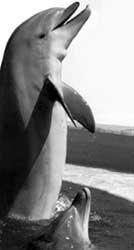Paints that prey
 during the last 10 years, largescale mortalities of bottlenose dolphins ( Tursiops truncatus ) have been reported along the Atlantic coast of the us . For the first time, large amounts of tributyltin ( tbt ) - organotin compounds used as an anti-fouling agent in paints (for painting ships and boats) - have been found in the deceased dolphins. As tbt is known to depress the immune system in mammals, K Kannan of the Skidaway Institute of Oceanography in Savannah, Georgia, us, suggests that the agent may have contributed to the death of the dolphins ( Environmental Science and Technology , Vol 31, No 1).
during the last 10 years, largescale mortalities of bottlenose dolphins ( Tursiops truncatus ) have been reported along the Atlantic coast of the us . For the first time, large amounts of tributyltin ( tbt ) - organotin compounds used as an anti-fouling agent in paints (for painting ships and boats) - have been found in the deceased dolphins. As tbt is known to depress the immune system in mammals, K Kannan of the Skidaway Institute of Oceanography in Savannah, Georgia, us, suggests that the agent may have contributed to the death of the dolphins ( Environmental Science and Technology , Vol 31, No 1).
Kannan notes that the us is the major producer and consumer of organotin compounds. The use of tbt on ships less than 82 feet long was banned in 1988, but it is still being used on large vessels and aluminium-hulled boats. As such, butyltin compounds ( bts) have accumulated in the sediments at the bottom of seas over the years, Kannan says, and thus the exposure of plants and animals to it is also persistent. Kannan's observations indicate continuing exposure of near-shore dolphins to organotin compounds. He found high concentrations of all bt s in the liver and kidneys of the dolphins. bt s were three-five times higher in bottlenose dolphins in comparison to spotted dolphins or pygmy sperm whales. This is because, while the latter are off-shore species, bottlenose dolphins are primarily coastal species occupying bays and estuaries.
bt concentrations increased in the early stages of the dolphins' lifecycle until maturity and then tended to remain constant. Adult male dolphins contained higher concentrations of bts than females. However, in immature stages, females had higher concentrations than males. Total bt concentrations in the livers of dolphins was around 1,400 nanograms per gram of liver tissue. Kidneys recorded the second-highest concentration among the various tissues analysed.
The tendency of bt accumulation in the livers and kidneys of vertebrates may be associated with the presence of and affinity to glutathione (a protein important for metabolism) in these organs. The greater accumulation of bt s has contributed to the immune dysfunction in dolphins. bt s are potent inhibitors of energy production in cells. Considering the high toxic potential of tbt and dibutyltin ( dbt ), it is probable that bt s have contributed to immune suppression. However, further studies are needed to establish the relationship between lymphocyte response and butyltin concentrations in diseased and healthy populations of bottlenose dolphins to understand the toxic threshold of these contaminants in marine mammals.
